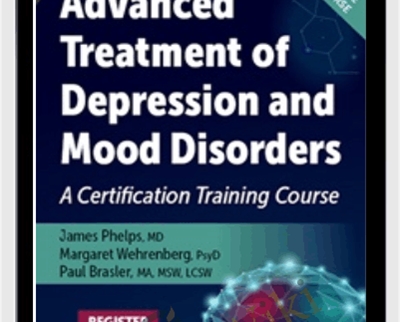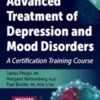$199.99 Original price was: $199.99.$75.00Current price is: $75.00.
21 Hours 8 Minutes
If you want to use leading-edge research to master successful clinical diagnoses so your clients get the treatment they need to thrive … then this is going to be the most important message you read all day. Here’s why …
 Purchase this course you will earn 75 Points worth of $7.50
Purchase this course you will earn 75 Points worth of $7.50Elevate your skills with the Advanced Treatment of Depression and Mood Disorders: A Certification Training Course – James Phelps & Others course, available for just $199.99 Original price was: $199.99.$75.00Current price is: $75.00. on Utralist.com! Browse our curated selection of over 60,000 downloadable digital courses across diverse Uncategorized. Benefit from expert-led, self-paced instruction and save over 80%. Start learning smarter today!
Be more confident diagnosing mood disorders, reduce the risk of suicide and self-harm & help your clients live more joyfully
If you want to use leading-edge research to master successful clinical diagnoses so your clients get the treatment they need to thrive … then this is going to be the most important message you read all day. Here’s why …
Between pure depression and Bipolar I lies a complex landscape of “mid-spectrum diagnoses,” including Bipolar II. The DSM has yet to fully recognize this spectrum of mood disorders. It still classifies depression and bipolar disorders as separate illnesses …
… Which contributes to the misdiagnosis of as many as 69% of bipolar disorder cases. More than one-third of these people remain misdiagnosed for 10 years or more. Mood disorder misinformation can have serious consequences for clients, including increased risk of suicide and self-harm.
According to the Archives of General Psychiatry, “Inappropriate treatment of bipolar disorder [BPD] is a serious problem in the U.S. population. Sub-threshold BPD is commonly occurring, clinically significant, and under-detected in treatment settings.”
To help you clear these hurdles to accurate diagnosis, we’ve created this exclusive, depression and mood disorder online training course. It will help you treat these conditions properly, and reduce the risk of client suicide.
What You’ll Discover In This Certification Training
PART ONE: Bipolar Disorders: Essentials for Clinical Practice with James Phelps, M.D.
MODULE I: Understanding the Complexities of Diagnosing Bipolar Disorder: Spectrum and DSM approaches
- Mnemonic devices to help remember the clusters of symptoms that make up a bipolar diagnosis
- Hypomania and how it differs from mania
- Using the MoodCheck tool, Bipolarity Index and non-manic bipolar markers such as family history and response to medication to recognize bipolarity
- An overview of the effectiveness—and limitations—of brain imaging tools in diagnosing bipolar disorder
MODULE II: What Causes Bipolar Disorder and An Overview of Treatment Options
- Exploring genetics, gut inflammation, circadian stress, hormones and trauma
- Determining what is bipolar disorder vs. depression, addictions or ADHD
- Bipolar-specific psychotherapy: recommended modalities and tools
- Using sleep rhythm, social rhythm and light and darkness as therapeutic tools
MODULE III: Medication Options and Implementing Bipolar Disorder Treatment
- Medications that can—and cannot—treat bipolar disorders: Risk factors, benefits and how to effectively add useful meds to a treatment plan
- How to use the “consultation to the client” model to help your clients taper off antidepressant medication
- An overview of a treatment plan that can help you implement this therapy in your practice
Get Advanced Treatment of Depression and Mood Disorders: A Certification Training Course – James Phelps & Others, Only Price $79
PART TWO: The 10 Best-Ever Depression Management Techniques: Managing Depression across the Lifespan, Raising Energy and Improving Cognition with Margaret Wehrenberg, Psy.D.
MODULE I: Understanding the Sources and Symptoms of Depression
- Core symptoms of depression you’ll likely encounter with clients
- Multiple causes of depression
- Bipolar disorder spectrum and depression
- The importance of self-care in managing depression—and great ways to practice it
- The role of medications
- Identifying depression triggers and ways to counteract them
MODULE II: Helping Your Clients Participate in Their Own Healing
- How to engage the client in their sessions and habit building
- How to help your clients replace negative thinking and habits with positive ones
- Helping clients to mobilize their energy to overcome lethargy
- Helping your clients to move out of isolation and engage in REAL social situations and friendships, not only social media
MODULE III: How to Help Your Clients Balance Their Lives
- What your clients can do to start feeling more positive and balanced in their lives
- Helping your clients overcome perfectionism and increase self-compassion
- Tools and processes for stopping destructive behavior
MODULE IV: Increasing Emotional Flexibility to Allow for More Positivity
- Developing interventions for bad moods
- How to reframe negative experiences to manage disappointment and reduce catastrophizing
- How to help your clients develop a tolerance for hope
- Cultivating a gratitude practice as part of helping your clients savor life
PART THREE: Suicide Assessment and Intervention: Today's Top Challenges for Mental Health Professionals with Paul Brasler, MA, MSW, LCSW
MODULE I: Laying the Groundwork for Understanding Suicide
- Why people choose suicide
- Identifying risk factors
- How to identify protective factors for suicide
MODULE II: Creating a Solid Suicide Assessment System
- Types of suicidal ideation and intent
- Two important things you must do before working with clients
- How to identify implicit suicidal intent
- Open-ended questions to ask to build the client-clinician relationship
- The importance of documentation: protect your clients (and your license)
MODULE III: Suicide Intervention Strategies
- Assessing a client’s suicide disposition
- Knowing when to hospitalize—and how to ensure their safety once there
- Why “contracting for safety” is an outdated and potentially dangerous, clinical tool (and what to do instead)
- Effective medications and treatments in reducing the risk of suicide
- Tools, processes and modalities you can use to improve outcomes with clients after the initial crisis has passed
- How to assess and treat non-suicidal self-injury (such as cutting) and other self-injurious behaviors
MODULE IV: The Connections Between Suicide, Mental Illness and Trauma
- Depressive, bipolar and psychotic disorders
- Personality disorders
- Substance use disorders
- Suicide clusters and pacts
- Homicide-suicide
- Assessing threats of future violence or homicide
MODULE V: Tips for Managing Our Anxiety as Clinicians
- The importance of self-care
- Self-care activities that can help reduce the risk of compassion fatigue or burnout
- Recognizing what you can control—and what’s out of your control
- The value of debriefing and peer supervision
Get Advanced Treatment of Depression and Mood Disorders: A Certification Training Course – James Phelps & Others, Only Price $79
Register today and get three FREE Bonus items
Bonus 1: Digital Seminar | 15 Must-Have Mindfulness Techniques for Clinicians: Skills to Transform Your Treatment Plans for Stress, Depression, Anxiety, Anger, Trauma, Guilt and Shame
Presented by Terry Fralich, LCPC (a $219.99 value)
- You’ll discover how to:
- Motivate clients to engage in treatment with easy-to-follow explanations of how mindfulness can affect these processes
- Use mindfulness practices in therapy to impact the stress reaction and shift clients to a relaxation response
- Incorporate mindfulness interventions into your treatment plans for depression and anxiety that can counter automatic patterns of thoughts
- Teach mindfulness and calming breathing techniques in-session to help clients manage their angered outbursts
- Calm the traumatized brain with grounding techniques and breathing exercises
- Appraise the clinical utility of mindfulness-based therapies in regulating shame and guilt
In addition, Terry gives you detailed instruction on his top mindfulness interventions to help your clients deal with guilt and shame and empower them to manage their anger and toxic emotions.
Bonus 2: PDF Workbook | The Depression and Bipolar Workbook: 30 Ways to Lift Your Mood & Strengthen the Brain
By Chris Aiken, MD (a $29.99 value)
- Learn how to recognize unique symptoms of depression and bipolar and match them with the latest advances in CBT, light and dark therapy, diet and sleep techniques, and strategies to fix out-of-sync biological clocks.
You’ll discover:
- Strategies to feel energized, lift mood and stay focused
- A sleep plan that doubles the effects of antidepressants
- Mood stabilizing interventions for morning, day and night
- Advanced treatment planning for insomnia
- Reproducible handouts, worksheets and charts
- And so much more!
This workbook will help you give your clients the tools they need to effectively manage depression and bipolar disorder.
Bonus 3: PDF Book | High Risk Clients: Evidence-based Assessment & Clinical Tools to Recognize and Effectively Respond to Mental Health Crises
By Paul Brasler, MA, MSW, LCSW (a $29.99 value)
- High Risk Clients provides a comprehensive, concise resource that you’ll turn to time after time to effectively intervene and keep clients safe:
- Recognize medical emergencies that present with psychological symptoms
- Suicide assessment and minimizing risk with realistic safety planning
- Tools and treatment protocols for substance abuse
- Strategies for trauma-informed care
- Prepare for the risk of violent behavior
- Downloadable assessments and handouts
- Practice case studies
- And much more!
This book will help you manage your more volatile clients and reduce the number of crises.
Get Advanced Treatment of Depression and Mood Disorders: A Certification Training Course – James Phelps & Others, Only Price $79
Tag: Advanced Treatment of Depression and Mood Disorders: A Certification Training Course – James Phelps & Others Review. Advanced Treatment of Depression and Mood Disorders: A Certification Training Course – James Phelps & Others download. Advanced Treatment of Depression and Mood Disorders: A Certification Training Course – James Phelps & Others discount.
Cultivate continuous growth with the Advanced Treatment of Depression and Mood Disorders: A Certification Training Course – James Phelps & Others course at Utralist.com! Unlock lifetime access to premium digital content, meticulously designed for both career advancement and personal enrichment.
- Lifetime Access: Enjoy limitless access to your purchased courses.
- Exceptional Value: Benefit from savings up to 80% on high-quality courses.
- Secure Transactions: Your payments are always safe and protected.
- Practical Application: Gain real-world skills applicable to your goals.
- Instant Accessibility: Begin your learning journey immediately after buying.
- Device Compatible: Access your courses seamlessly on any device.
Transform your potential with Utralist.com!
Related products
Uncategorized
Cognitive Rehabilitation Therapy: Practical Interventions and Personalized Planning – Jane Yakel
= 85 Points
= 94 Points
= 72 Points
Uncategorized
= 30 Points
Uncategorized
= 85 Points
= 85 Points
Uncategorized
Optimizing Compliance and Maximizing Revenue for Ophthalmology and Optometry – Jeffrey P. Restuccio
= 85 Points
= 84 Points





